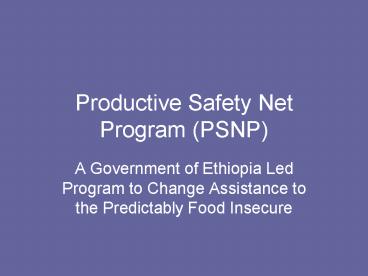Productive Safety Net Program PSNP - PowerPoint PPT Presentation
1 / 18
Title:
Productive Safety Net Program PSNP
Description:
A Government of Ethiopia Led Program to Change Assistance to the Predictably Food Insecure ... Increased development assistance to build assets ... – PowerPoint PPT presentation
Number of Views:454
Avg rating:3.0/5.0
Title: Productive Safety Net Program PSNP
1
Productive Safety Net Program (PSNP)
- A Government of Ethiopia Led Program to Change
Assistance to the Predictably Food Insecure
2
Predictable Food Insecurity
3
Percent of Rural Population Needing Assistance
10 Year Maximum
4
(No Transcript)
5
Increasing vulnerability and destitution Trends
in Destitution in the North Eastern Highlands of
Amhara 2003 Sharp, Devereaux and Amare
6
Increasing Food Insecurity
- Rising predictably food insecure population
- Overwhelming humanitarian case load
- Shocks are becoming more frequent
- Asset depletion and destitution are rising with
each emergency
7
1984 versus 2003
- Population
- 1984 45 million people
- 2003 69 million people
- GDP
- 1984 190
- 2003 108
- People requiring emergency assistance
- 1984 8 million
- 2003 14 million
8
How to Break the Cycle?
- Recognized need for
- Increased development assistance to build assets
- Better and more productive use of humanitarian
assistance - Asset protection during shocks
- Predictable resources for predictable problems
9
Productive Safety Net Program (PSNP)
- Cash or Food Resource Transfers to meet basic
needs - Labor Based Public Works
- Direct Support
- Protect household assets
- Appropriate assistance arrives on time
- Build community assets
- Provide resources in exchange for labor or other
productive behavior
10
Productive Safety Net Components
- Predictable resources for predictable needs
- Food transfers in areas with
- Limited capacity
- Limited access to markets
- Cash transfers will stimulate markets and allow
for limited asset building - Government-led program designed in collaboration
with all donors
11
2004 Safety Net Target Beneficiaries 262
Districts and 5.1 Million People
12
2005 Worst Case 12.6 million people5.1 million
Safety Net 7.5 million emergency
Safety Net Emergency
Emergency Only
13
How is this different?
- Reform emergency appeal
- Food Security Coordination Bureau (FSCB) newly
responsible for predictable caseload - Move towards cash transfers
- Predictable resourcing allows better planning
- Beneficiaries can take more risks because they
can depend upon the time and quantity of their
transfer - More effective planning possible
- Greater likelihood of food or cash arriving
before assets are depleted
14
Results Expected
- PSNP
- Household assets protected
- Community assets built
- Revise emergency appeal system
- Overall goal of graduation from food insecurity
requires hh asset creation and diversification
that are not included in PSNP
15
Rural Growth
High Potential Areas
80 to 85 Rural
Food Security Program
Chronically Food Insecure 5-6 Million PSNP 262
Woredas
15 Million Food Insecure
Coalition Plan for Food Security
Small Market/Town Development
Export Promotion
16
(No Transcript)
17
USAID Support to the PSNP
- PSNP Productive Safety Net Program
- 150 million Title II (NGO/WFP)
- SPSNP Support to the Productive Safety Net
Program - 16 million in IDA Famine Fund
- MLVP Market-Led Livelihoods for Vulnerable
Populations - 2 million IDA Famine Fund
- Start up and immediate capacity building for PSNP
- 880,000 IDA Famine Fund
18
Issues Requiring Attention
- FSCB capacity to reach 5.1 million people
starting January 1, 2005 - Emergency year in 2005 highlights the need for
linkages between DPPC and FSCB. - Pastoral areas lack capacity and require
specialized intervention - Contingency planning for food price increases in
cash areas with cash transfers - Due to the humanitarian risks of program failure,
implementation monitoring is critical - Direct support must be made available to those
who cannot work.































